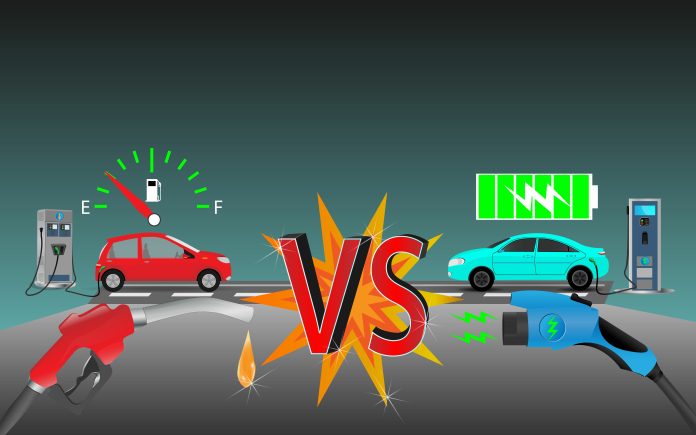While internal-combustion cars often match or exceed their EPA highway fuel economy numbers, data from C/D‘s highway tests show that EVs are far worse at meeting expectations.
SAE International has published a paper co-authored by Car and Driver‘s testing director, Dave VanderWerp, showing that, “in our testing, EVs are far worse at matching EPA estimates than gas-powered vehicles.”
In the newest paper published by (SAE International, formerly named the Society of Automotive Engineers, which is a United States-based, globally active professional association and standards developing organization for engineering professionals in various industries). This study incorporates Car and Driver‘s real-world highway test data to show that electric vehicles underperform on real-world efficiency and range relative to the EPA figures by a much greater margin than internal-combustion vehicles.
While the ICE vehicles typically meet or exceed the EPA-estimated highway fuel economy numbers, EVs tend to fall considerably short of the range number on the window sticker. This points out a real need for revised testing and labeling standards for EVs.
SAE incorporated Car and Driver‘s real-world highway test data to show that electric vehicles underperform on real-world efficiency and range relative to the EPA figures by a much greater margin than internal-combustion vehicles. To repeat: ICEs typically meet or exceed the EPA-estimated highway fuel economy numbers, EVs tend to fall considerably short of the range number on the window sticker.
“Basically, we’ve taken a look at how vehicles perform relative to the values on the window sticker, looking at the difference between what the label says and what we actually see in our real-world highway test,” explained VanderWerp. “We see a big difference in that gap between gas-powered vehicles and the performance of EVs. The real question is: When first-time customers are buying EVs, are they going to be pleasantly surprised or disappointed by the range?”
The paper, written by Car and Driver’s testing director, Dave VanderWerp, and Gregory Pannone underscore the necessity for revised testing and labeling standards for EVs moving forward.
While consumers continue the transition from internal combustion engine (ICE), vehicles to battery electric vehicles (BEV), the combined study shows they should not expect the same fuel economy MPG on the label to comparative on the road results. Manufacturer’s current labeling procedures for EVs allow a very low starting point of 0.7 or higher multiplier to be applied to the unadjusted fuel economy and range values.
For ICE-powered vehicles, the adjustment factor decreases with increasing unadjusted fuel economy and can even be lower than 0.7. To better inform consumers, starting in 2016, Car and Driver added an on-road highway fuel-economy test, conducted at 120 kph (75 mph) comparing the performance measurement that it’s been tracking since the 1950s. For electric vehicles, testing includes an evaluation of the all-electric range.
The actual driving test results were compared side-by-side with the certification information for each vehicle model including the unadjusted vs. label fuel economy and range, road load force coefficients, and labeling options. The energy needed for traction as well as the kinetic energy available from regenerative braking systems were computed from the certification information to evaluate the differences between actual on-road tests and rolling tests that were conducted during the certification process.
Surprisingly, the testing results show that the highway fuel economy label tends to be a very good predictor of the fuel economy observed during the on-road test at real highway speeds with vehicles powered by an ICE. But most EVs tested to date fall short of both their electric consumption and range label values. For EVs, the difference between the label and on-road consumption and range is negatively affected by factors like extreme temperatures and suggestions by automakers to charge to less than 100 percent to supposedly extend battery life.
“… more people end up being disappointed in the numbers,” VanderWerp said. “They should all be tested the same, and it should be closer to the real world than it is now.”
In conclusion, these results support the need to re-evaluate the labeling procedures for EV technology as it continues to become increasingly prominent in the marketplace.
Large factories that consume huge amounts of power are required for the mass production of fuel-burning vehicles, with the process itself having a significant carbon footprint. In fact, for every gasoline or diesel car produced, around 5.6 tons of CO2 are released into the atmosphere.
Unfortunately, EV manufacturing isn’t much better. Producing EVs is a very energy-intensive process that comes with its own carbon footprint. The majority of EV factories do not use renewable power, meaning their energy is sourced from non-renewable fossil fuels (such as coal, oil, and gas) that also harm the environment. The production of EV batteries is also a harmful process involving dangerous and lethal chemicals like Lithium) which can lead to fires and explosions. Mining these minerals are often done by minors in foreign countries with little or no experience and with no safety standards to protect them against the harmful effects of handling them.
The authors propose solutions like more standardized testing procedures and the inclusion of both city and highway range figures on new vehicles’ window price stickers.
Both EVs and ICEs should be considered an environmental hazard. Future developments may make EVs far less dangerous for the environment, but only time will tell whether that ever happens.


Is the oil and gas money worth being this stupid?